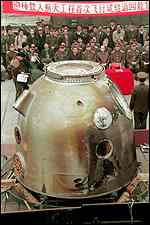Dr David Whitehouse . BBC News . 25 march 2002
 A manned flight could come next year |
 Shenzhou II orbited the Earth 108 times |
 The first capsule was put on display after its return |
China has launched another prototype space capsule designed to carry humans into orbit.
The Shenzhou III craft blasted away from the Jiuquan Space Launch Centre in northwest Gansu Province at 2200 Beijing time (1400 GMT) on Monday.
The capsule is said to be carrying with it a model of an astronaut in preparation for a future manned mission that is expected to take place next year at the earliest.
Confirming the launch, the official Chinese news agency Xinhua said Shenzhou III had "functions identical to a manned craft".
Xinhua said Chinese scientists had designed life sciences, materials, astronomy and physics experiments to be performed during the craft's journey, but did not mention when re-entry was expected.
The launch of Shenzhou III was watched by Chinese President Jiang Zemin, Xinhua said.
China wants to become the third nation to put humans into space after the United States and the former Soviet Union.
Divine Vessel
News that China was about to send another capsule into orbit came during the Fifth Session of the Ninth National People's Congress and the Ninth National Committee of the Chinese People's Political Consultative Conference.
The Shenzhou III launch had been delayed because of technical difficulties, according to space administrator Hu Shixiang, who was quoted by the China News Service. Shenzhou III was put into orbit by a new CZ-2F rocket.
A Chinese newspaper reported that the tracking vessel Yuanwang 4 set sail to its designated location in recently; three other vessels in the fleet were also said to be on course to tracking posts.
The first test flight of the Shenzhou (Magic or Divine Vessel) programme was in November 1999, when a capsule orbited the Earth 14 times in a 12-hour mission aimed at testing launch and re-entry systems.
Moon goal
Shenzhou II, launched in January 2001, orbited the Earth 108 times and tested life support systems before returning nearly a week later to a press blackout that left Western analysts suspecting a re-entry failure. Chinese officials denied this.
Just as with the Shenzhou II mission, the Shenzhou III re-entry capsule will leave its orbital module circling the Earth for about six months.
Chinese officials are reported to have said that there could be another unmanned test mission later this year as the country gears up to a proper manned launch, perhaps in 2003.
Space officials have said that a goal of China's space programme is to put a Chinese astronaut on the Moon one day.